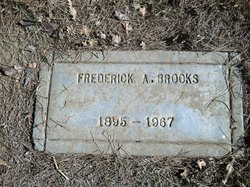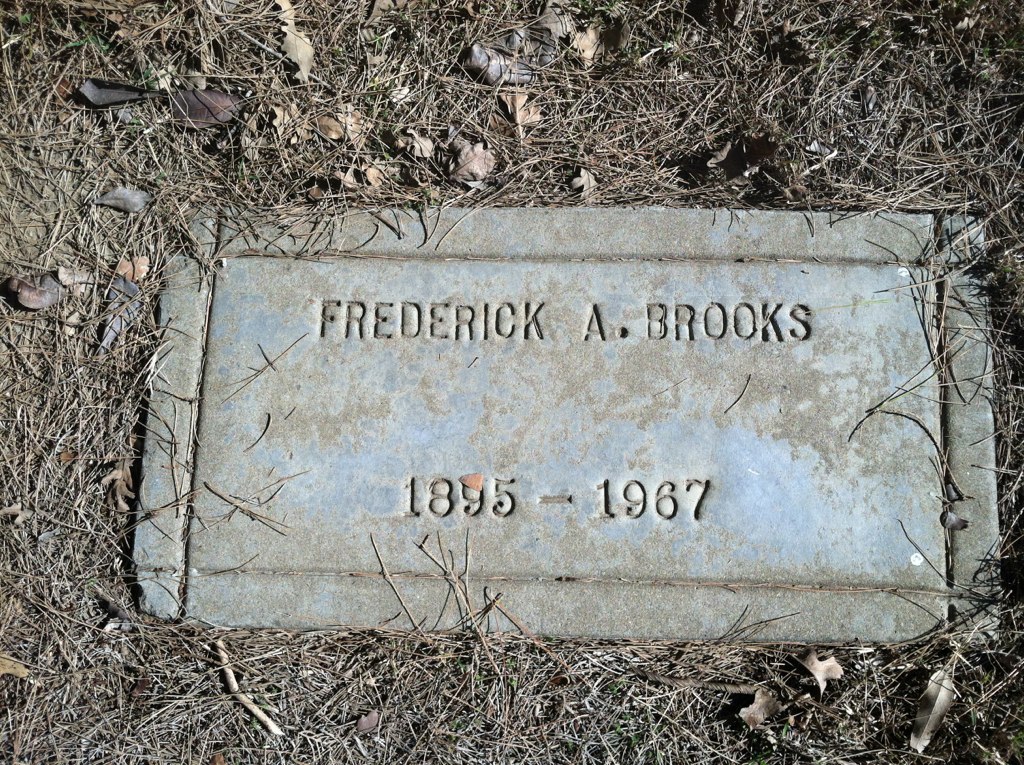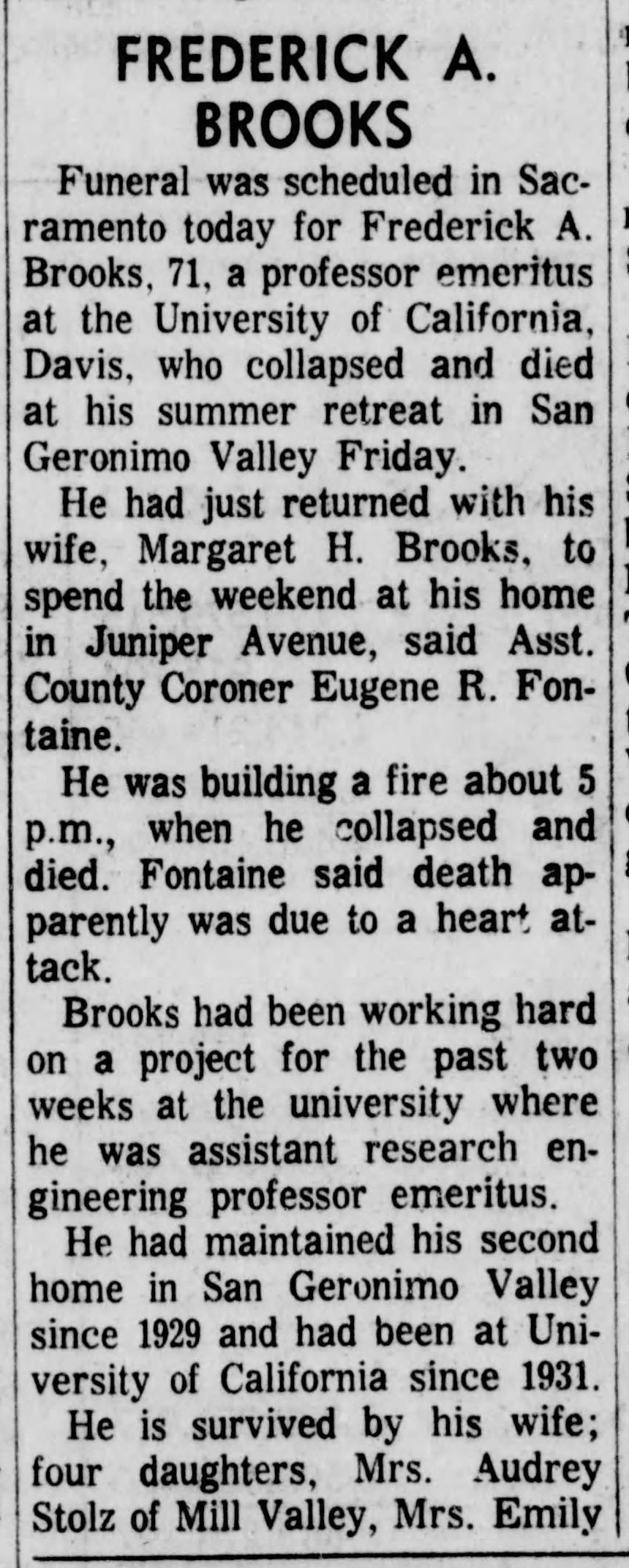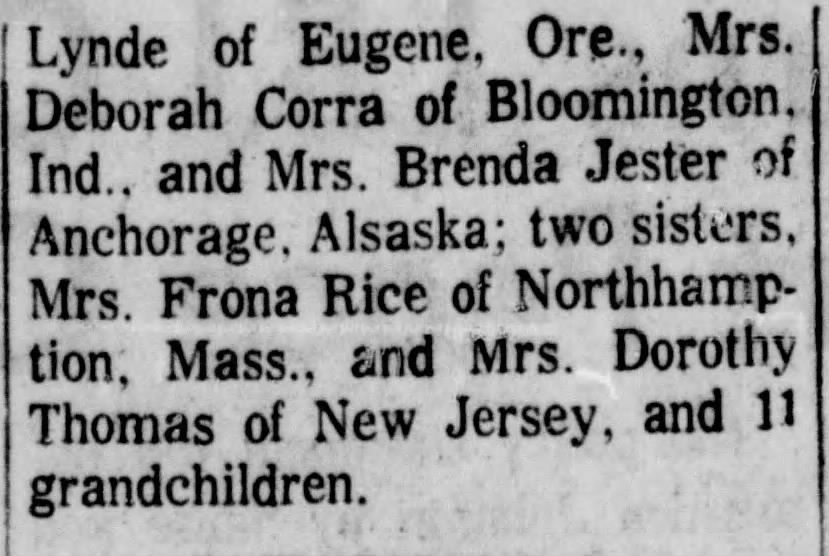University of California: In Memoriam, May 1968
Frederick A. Brooks, Agricultural Engineering: Davis, 1895-1967, Professor Emeritus
The death, in March of 1967, of Dr. Frederick A. Brooks brought to an end the teaching and research career of one who played an important role in developing the field of bioclimatology, the study of the effects of weather on living things.
Frederick A. Brooks was born in Minneapolis, Minnesota, on May 1, 1895, the son of Morgan and Frona Marie Brooks. In 1913 he entered the University of Illinois, where his father was then Professor of Electrical Engineering. He received the B.S., with honors, in electrical engineering in 1917. From 1918 to 1920 he was a graduate student at the Massachusetts Institute of Technology, where he was awarded the Master of Science degree in 1919 and the Doctor of Science degree in aeronautical engineering in 1920. In 1927 he was awarded the professional degree of Mechanical Engineer by the University of Illinois, in recognition of his stress analysis studies in industrial applications.
Before coming to the Davis campus in 1931, Dr. Brooks spent more than ten years in the industrial field. He served as airplane designer for Curtiss Aeroplane and Motor Corporation and as assistant engineer of Dunlop Tire and Rubber Company, both of Buffalo, New York. He also held the position of chief engineer at Johnson Gear Company and at Apache Motor Corporation and was assistant to the chief engineer at the Byron Jackson Company in California. During this period he also served one year (1922-23) as a teaching fellow in the physics laboratory at the University of California at Berkeley.
In 1931 Dr. Brooks accepted an appointment as Associate Agricultural Engineer in the Experiment Station at Davis. Three years later he was given the added academic title of Associate Professor of Agricultural Engineering. In 1941 he attained the Professorship.
During 36 years of an active and fruitful career, Dr. Brooks contributed significantly to the field of agricultural engineering. His early work involved studies of the abrasive effects of agricultural dusts on internal-combustion engines. Results of this work aided in the development of testing techniques and standards for engine air cleaners. Other areas of research included use of solar energy for heating of water, measurement and evaluation of orchard heater smoke, development of an electric drawbar dynamometer, physical factors associated with sugar beet storage, and statistical analysis of systems for the precise placement of sugar beet seed.
With this abundance of ideas he was often far ahead of his time--in the development of automatic weather recording, for instance. Also, he was one of the first to warn about the danger from drifts of poisonous dusts applied by aircraft. His principal effort, however, has been in the field of agricultural climatology. Through the last thirty years of his life the major portion of his time was devoted to study of the engineering aspects of the climate in which plants grow.
Dr. Brooks' interest in the microclimate developed through research on the protection of citrus orchards from frost. Through this work he recognized the importance of a better understanding of the modes of heat and mass transfer in the total plant environment. His dedicated effort brought him international recognition as an authority on microclimatology. In 1943 he was a consultant to the Chemical Warfare Service at the Dugway Proving Grounds in Utah. In 1944 he served on assignment with the U.S. Navy as consultant on the effects of surface air turbulence on smoke screens. In 1947 he was a research fellow at the Blue Hill Meteorology Observatory at Harvard University. In 1953 he was invited to participate in the U.S. Air Force project on atmospheric turbulence research in Nebraska. In 1955 he received a fellowship and travel grant from Harvard University for a study of micro-climate research. In 1957 he was one of four U.S. delegates to the UNESCO symposium on arid zone climatology, held in Canberra and Melbourne, Australia. In 1959 he was awarded a Guggenheim fellowship for study in England. Although he retired formally in 1962, he continued his research under a grant from the U.S. Army Signal Corps. He was active in this program up to his death.
Appreciation of Dr. Brooks' contributions to his profession, his University, and his community was well demonstrated by his colleagues. He was the 1950 Faculty Research Lecturer on the Davis campus, speaking on "Atmospheric Radiation." He was the 1960 recipient of the Cyrus Hall McCormick medal from the American Society of Agricultural Engineers "For Exceptional and Meritorious Engineering Achievement in Agriculture." He was honored in 1966 by the American Meteorological Society for "outstanding achievement in bioclimatology."
Dr. Brooks also served well in teaching and association with students. He developed and offered courses in agricultural climatology, and many graduate students pursued programs under his careful direction. He also served a period as advisor for all graduate students in Agricultural Engineering. He welcomed discussions and made his time generously available to colleagues on any problem. Generally he was a strong advocate of cooperative projects.
Dr. Brooks was a Fellow of the American Meteorological Society and the American Society of Agricultural Engineers. He was a member of the American Geophysical Union and the Society of Sigma Xi.
Dr. Brooks is survived by his wife, Margaret Henshaw Ward, whom he married in 1929; by four daughters, Audry, Emily, Deborah, and Brenda; and by 11 grandchildren.
University of California: In Memoriam, May 1968
Frederick A. Brooks, Agricultural Engineering: Davis, 1895-1967, Professor Emeritus
The death, in March of 1967, of Dr. Frederick A. Brooks brought to an end the teaching and research career of one who played an important role in developing the field of bioclimatology, the study of the effects of weather on living things.
Frederick A. Brooks was born in Minneapolis, Minnesota, on May 1, 1895, the son of Morgan and Frona Marie Brooks. In 1913 he entered the University of Illinois, where his father was then Professor of Electrical Engineering. He received the B.S., with honors, in electrical engineering in 1917. From 1918 to 1920 he was a graduate student at the Massachusetts Institute of Technology, where he was awarded the Master of Science degree in 1919 and the Doctor of Science degree in aeronautical engineering in 1920. In 1927 he was awarded the professional degree of Mechanical Engineer by the University of Illinois, in recognition of his stress analysis studies in industrial applications.
Before coming to the Davis campus in 1931, Dr. Brooks spent more than ten years in the industrial field. He served as airplane designer for Curtiss Aeroplane and Motor Corporation and as assistant engineer of Dunlop Tire and Rubber Company, both of Buffalo, New York. He also held the position of chief engineer at Johnson Gear Company and at Apache Motor Corporation and was assistant to the chief engineer at the Byron Jackson Company in California. During this period he also served one year (1922-23) as a teaching fellow in the physics laboratory at the University of California at Berkeley.
In 1931 Dr. Brooks accepted an appointment as Associate Agricultural Engineer in the Experiment Station at Davis. Three years later he was given the added academic title of Associate Professor of Agricultural Engineering. In 1941 he attained the Professorship.
During 36 years of an active and fruitful career, Dr. Brooks contributed significantly to the field of agricultural engineering. His early work involved studies of the abrasive effects of agricultural dusts on internal-combustion engines. Results of this work aided in the development of testing techniques and standards for engine air cleaners. Other areas of research included use of solar energy for heating of water, measurement and evaluation of orchard heater smoke, development of an electric drawbar dynamometer, physical factors associated with sugar beet storage, and statistical analysis of systems for the precise placement of sugar beet seed.
With this abundance of ideas he was often far ahead of his time--in the development of automatic weather recording, for instance. Also, he was one of the first to warn about the danger from drifts of poisonous dusts applied by aircraft. His principal effort, however, has been in the field of agricultural climatology. Through the last thirty years of his life the major portion of his time was devoted to study of the engineering aspects of the climate in which plants grow.
Dr. Brooks' interest in the microclimate developed through research on the protection of citrus orchards from frost. Through this work he recognized the importance of a better understanding of the modes of heat and mass transfer in the total plant environment. His dedicated effort brought him international recognition as an authority on microclimatology. In 1943 he was a consultant to the Chemical Warfare Service at the Dugway Proving Grounds in Utah. In 1944 he served on assignment with the U.S. Navy as consultant on the effects of surface air turbulence on smoke screens. In 1947 he was a research fellow at the Blue Hill Meteorology Observatory at Harvard University. In 1953 he was invited to participate in the U.S. Air Force project on atmospheric turbulence research in Nebraska. In 1955 he received a fellowship and travel grant from Harvard University for a study of micro-climate research. In 1957 he was one of four U.S. delegates to the UNESCO symposium on arid zone climatology, held in Canberra and Melbourne, Australia. In 1959 he was awarded a Guggenheim fellowship for study in England. Although he retired formally in 1962, he continued his research under a grant from the U.S. Army Signal Corps. He was active in this program up to his death.
Appreciation of Dr. Brooks' contributions to his profession, his University, and his community was well demonstrated by his colleagues. He was the 1950 Faculty Research Lecturer on the Davis campus, speaking on "Atmospheric Radiation." He was the 1960 recipient of the Cyrus Hall McCormick medal from the American Society of Agricultural Engineers "For Exceptional and Meritorious Engineering Achievement in Agriculture." He was honored in 1966 by the American Meteorological Society for "outstanding achievement in bioclimatology."
Dr. Brooks also served well in teaching and association with students. He developed and offered courses in agricultural climatology, and many graduate students pursued programs under his careful direction. He also served a period as advisor for all graduate students in Agricultural Engineering. He welcomed discussions and made his time generously available to colleagues on any problem. Generally he was a strong advocate of cooperative projects.
Dr. Brooks was a Fellow of the American Meteorological Society and the American Society of Agricultural Engineers. He was a member of the American Geophysical Union and the Society of Sigma Xi.
Dr. Brooks is survived by his wife, Margaret Henshaw Ward, whom he married in 1929; by four daughters, Audry, Emily, Deborah, and Brenda; and by 11 grandchildren.
Family Members
Sponsored by Ancestry
Advertisement
Explore more
Sponsored by Ancestry
Advertisement











